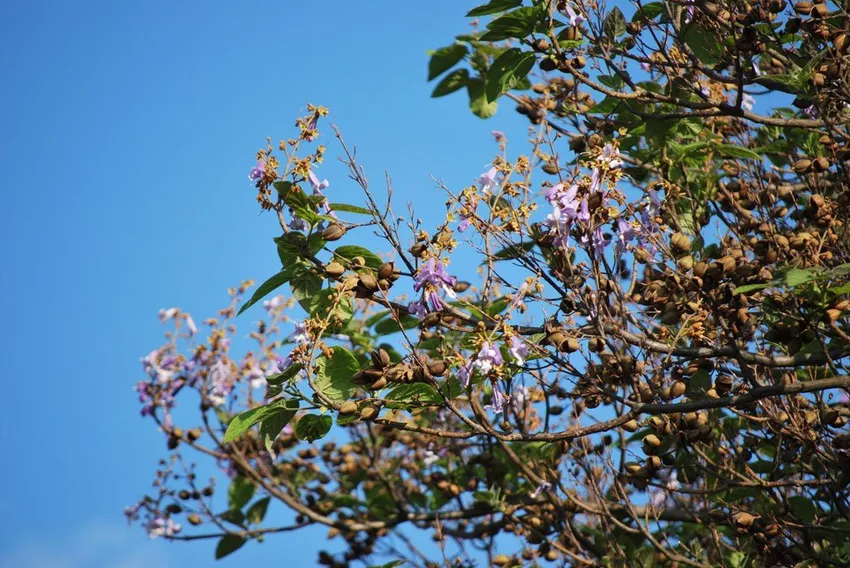You don't have to be a professional gardener to propagate the bluebell tree. Even amateurs can propagate with cuttings or seeds.

Anyone who already owns a blue bell tree (Paulownia tomentosa) does not have to worry about propagation. The emperor tree takes care of itself that its species does not die out. The seeds are scattered particularly widely, so that numerous bluebell trees shoot out of the ground in the vicinity and in return one should take care to remove the seeds in good time. For all those who would like to get this pretty plant from the Far East, you will find tips for species-appropriate propagation below.
The bluebell tree can be propagated in the following ways:
- Cuttings
- Seeds
❶ Bluebell tree - Propagation by cuttings
Even gardening amateurs will easily be able to propagate a bluebell tree with the help of cuttings. The only problem with this is that there should be an emperor tree nearby. The cuttings are cut in autumn. This can be done as part of pruning measures. If a neighbor is involved, he will certainly be willing to give up some cuttings.
The cuttings should be about 20 centimeters long and not too woody. It is also important to ensure that there are several eyes on the shoot. This is where the leaves sprout later. Immediately after cutting, the branches are placed in a planter filled with a nutrient-rich and loose substrate. Now a little patience is required. The plant pot is placed in a bright and warm location and kept consistently moist, but not wet. The cuttings overwinter indoors and root over the winter. In spring, when no more night frosts are to be expected, the planter can be placed on the balcony or terrace.
Propagation by cuttings at a glance:
- Cutting
- Prepare planter
- Insert cutting
- Set up cuttings warm and bright
- Keep the cutting moist
- Winter cuttings
- Wait for root formation
- Put the cuttings outside in spring
❷ Bluebell Tree - Propagation by seed
The bluebell tree usually takes care of its own propagation. The seeds fall to the ground and are carried away by the wind. As a result, a number of young plants grow on their own lawn or on the property of their neighbors. If there is already an emperor tree, propagation is not an issue.
If you want to grow a bluebell tree, you can collect the seeds from existing trees or buy them from specialist retailers.
It is best to sow in February. The seeds are grown in shallow seed trays. Peat is the best substrate. The seeds are distributed on the substrate without being covered with soil. During cultivation, the seed should be kept evenly moist. However, waterlogging must not occur.
» Tip: Covering the planter with a foil or glass cover speeds up the germination process.
Covered planters should be aired regularly, otherwise mold can form. The seeds will germinate in about a week in a bright, warm spot. When the seedlings have grown to a height of about five centimetres, they should be isolated and placed in separate planters. Now the young plants are gradually accustomed to being outdoors. This only happens during the day at first. If late frost is no longer to be expected, the planters can spend the summer on the balcony or terrace.
Growing from seeds - step by step
- Win Seeds
- Fill the planter with soil
- Insert seeds
- Place the planter bright and warm
- Keep the planter regularly moist
- Wait for germination
Propagation methods with their advantages and disadvantages
| Propagation method | Advantages | Cons |
|---|---|---|
| Cuttings | ✔ Cuttings can easily be obtained from existing plants. ✔ The propagation method is simple and promises high chances of success. | ✘ The cuttings are taken in the fall and need to hibernate in a warm and light place until roots form. ✘ A plant must be present to take cuttings. |
| Seeds | ✔ Sowing is easy and several plants can be grown at the same time. ✔ Germination starts quickly. ✔ Seeds can be obtained from existing plants. | ✘ If no plant is available, the seeds must be purchased. |
»Tip: The easiest way to get a bluebell tree is to dig up a young plant from the ground and place it in a planter at home. If the plants grow nearby, this will not be difficult. Care should be taken when digging up the young plant so that the delicate roots are not damaged.
What happens to the young plants?
Young plants do not yet have a fully developed root system and are more sensitive than a mature bluebell tree. The little plants need a lot of sun right from the start. A sheltered outdoor stand is an advantage. Young plants should be watered regularly. It is particularly important to ensure that there is no waterlogging in the planter.
Drainage in the bottom of the planter protects against waterlogging, as the irrigation water can drain off better. Young plants are cultivated indoors until there is no longer any threat of late frosts. In the first two years after planting, the small emperor trees need winter protection. As soon as the first night frosts are predicted, the planters are brought indoors and overwintered in a light and dry place at around eight to ten degrees.
» Tip: Young emperor trees are not hardy. In the first few years, keeping buckets is therefore recommended.
What should be considered when caring for young plants?
- water regularly
- lots of sun
- no waterlogging
- Prefer bucket posture
- Assign winter quarters in the house